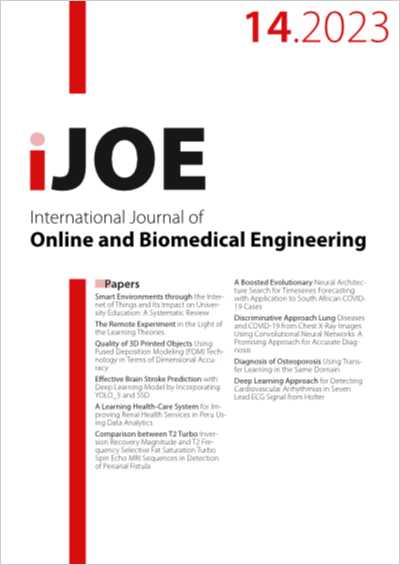Comparison between T2 Turbo Inversion Recovery Magnitude and T2 Frequency Selective Fat Saturation Turbo Spin Echo MRI Sequences in Detection of Perianal Fistula
DOI:
https://doi.org/10.3991/ijoe.v19i14.42557Keywords:
perianal fistula, magnetic resonance imaging, turbo inversion recovery magnitude, frequen-cy selective turbo spin echo.Abstract
Fat suppression magnetic resonance imaging (MRI) sequences are routinely included in the MRI protocol for patients with perianal fistula to improve the visibility of the abnormal tracts and abscesses against the background of hypo-signal intensity on the image. The objective of this study is to compare the turbo inversion recovery magnitude (TIRM) and frequency selective fat saturation turbo spin echo (FSTSE) MRI sequences in detecting perianal fistulas in terms of time and clarity. The MRI protocol included a coronal T2 turbo inversion recovery magnitude sequence, a T2 fat saturation turbo spin echo, and T2 turbo inversion recovery magnitude sequences in the axial plane. The evaluation of sequence image quality involved calculating the signal-to-noise ratio (SNR) and contrast-to-noise ratio (CNR). Additionally three radiologists assessed the best image using a questionnaire designed to align with the study’s objectives. The T2 TIRM sequence was found to have the highest number of ticked images. The inter-rater kappa agreement showed fair agreement (k = 0.370) between the raters. However, the SNR and CNR values for the T2 FSTSE were higher than those of the T2 TIRM sequence, with a p-value less than 0.001. There is a significant difference in the meantime in that the T2 TIRM sequence has less time than the T2 FSTSE with a p-value < 0.001. Due to its uniform fat suppression in the MR image and shorter acquisition time, the turbo inversion recovery magnitude sequence exhibited superior performance compared to the T2 frequency-selective turbo spin echo sequence.
Downloads
Published
How to Cite
Issue
Section
License
Copyright (c) 2023 Noor Baqir, Rasha Ahmed, Khaleel Mohsen

This work is licensed under a Creative Commons Attribution 4.0 International License.


